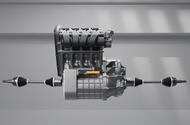Innovative Hybrid Powertrain: A Game Changer for Electric Vehicles
The automotive industry is undergoing a significant transformation, with electric vehicles (EVs) at the forefront of this evolution. However, as the transition to all-electric lineups slows for some manufacturers, a new hybrid powertrain developed by the joint venture Horse, formed by Geely and the Renault Group, is emerging as a compelling solution. This innovative powertrain is designed to retrofit existing electric cars, offering a seamless blend of traditional and electric driving technologies.
Understanding the Hybrid Powertrain’s Design
At the heart of Horse’s new offering is a compact hybrid powertrain that integrates an internal combustion engine, electric motor, gearbox, and essential electronics into a single unit. This design allows it to occupy the same space as a conventional EV motor, making it an attractive option for manufacturers looking to enhance their vehicle lineup without extensive re-engineering or the need for new production lines.
The versatility of this powertrain is noteworthy. It can be fueled by various energy sources, including petrol, E85 ethanol-petrol mix, pure methanol, and synthetic fuels. This flexibility not only broadens the appeal of the hybrid system but also aligns with the growing demand for sustainable fuel options.
Moreover, the powertrain can function in two distinct modes: as a traditional parallel hybrid, where it drives the wheels directly, or as a range extender, generating electricity to power the vehicle’s drive motor. This dual functionality offers manufacturers and consumers alike the best of both worlds, combining the efficiency of electric driving with the familiarity of internal combustion engines.
Responding to Market Dynamics
The introduction of Horse’s hybrid powertrain comes at a time when several automotive manufacturers are reassessing their strategies regarding electric vehicles. For instance, Fiat is developing a new version of its 500e, retrofitted with a hybrid powertrain to replace the older petrol model. This move highlights the challenges faced by EV sales and the need for manufacturers to adapt to changing market conditions.
Matias Giannini, CEO of Horse Powertrain, emphasizes the shift towards a technology-neutral approach in the automotive sector. He notes that while battery-electric vehicles were once seen as the sole path to achieving net-zero emissions, the reality is more complex. Different markets and applications are now exploring diverse sustainable mobility solutions, and Horse’s hybrid unit provides a way for original equipment manufacturers (OEMs) to diversify their offerings with minimal disruption to their existing production processes.
The Benefits of Retrofitting
One of the most significant advantages of Horse’s hybrid powertrain is its retrofitting capability. By allowing manufacturers to integrate this unit into their existing electric vehicle platforms, it reduces the need for costly and time-consuming redesigns. This approach not only saves resources but also enables manufacturers to respond more swiftly to consumer demand for hybrid options.
For example, consider the case of a mid-sized electric SUV that has seen a decline in sales due to consumer preferences shifting towards hybrid models. By retrofitting this vehicle with Horse’s hybrid powertrain, the manufacturer can quickly adapt to market trends, offering a new product that appeals to a broader audience while maintaining their existing production infrastructure.
Looking Ahead: A Diverse Future for Mobility
As the automotive landscape continues to evolve, the introduction of hybrid powertrains like Horse’s represents a significant step towards a more diverse and sustainable future. With the ability to cater to various fuel types and driving preferences, this technology not only enhances vehicle performance but also aligns with global sustainability goals.
In conclusion, Horse’s innovative hybrid powertrain exemplifies how the automotive industry can adapt to changing market dynamics while embracing new technologies. By offering a solution that blends the best of both electric and traditional driving, manufacturers can meet consumer demands for flexibility and sustainability, paving the way for a more diverse and resilient automotive future.

